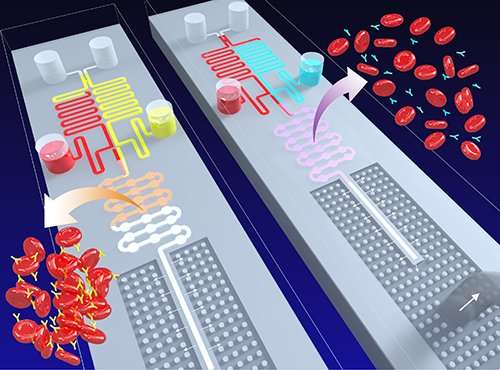New device brings us closer to coin-sized medical labs

It sounds like a science fiction movie: Using a handheld device, a doctor draws blood from a patient and, seconds later, the device provides in-depth medical information about the patient.
The idea—shrinking a medical lab onto a chip the size of a small coin—is known as "lab on a chip." It's closer to reality than you might think, but obstacles remain; among them is finding an efficient and reliable way to mix and move blood and other fluids through the chip's tiny valves and pumps.
A new study, appearing on the cover of the Jan. 21 edition of the journal Lab on a Chip, moves the scientific community closer to solving the problem.
The study describes how a multidisciplinary research team at the University at Buffalo fabricated a chip that uses two different types of force—capillary- and vacuum-driven—to manipulate how fluids travel in micro- and nano-sized channels.
The advancement solves a vexing issue, the researchers say, because in such devices, when blood is mixed with a reagent to produce a biological and/or chemical reaction, the pressure difference between the two fluids often causes them to flow backward instead of into the desired channel.
"It's kind of like plumbing; we're moving fluids around and dealing with different pressures and flows. Only we're doing it on a microchip, as opposed to a house," said Kwang W. Oh, Ph.D., UB associate professor of electrical engineering and biomedical engineering, and the study's lead author.
Oh continued: "The chip could become the basis for faster, more efficient and reliable lab on a chip devices. It puts us closer to using such devices where medical labs are lacking, such as the developing world, battlefields and even our homes."
In a series of experiments, the research team showed how its chip was able to accurately decipher the eight blood types based upon time it takes for different blood types to flow through the chip. For example, when mixed with a certain antibody, Type A blood will thicken and flow slower.
Oh says the device could be used for other biological and chemical assays. What's more, the new chip requires no sensors or external sources of power. That's key for medical device manufacturers, which are searching for ways to inexpensively produce disposable lab on a chip products.
More information: Yaguang Zhai et al. A robust, portable and backflow-free micromixing device based on both capillary- and vacuum-driven flows, Lab on a Chip (2017). DOI: 10.1039/C7LC01077J

















